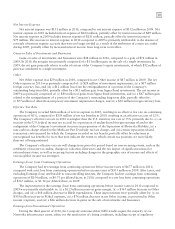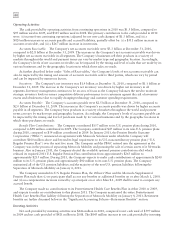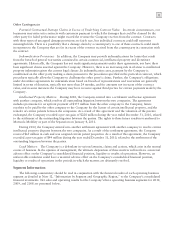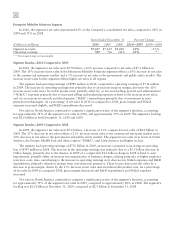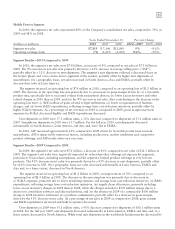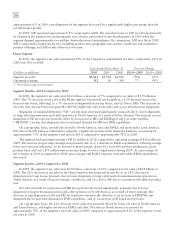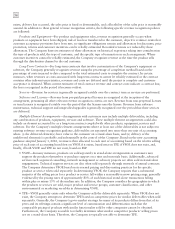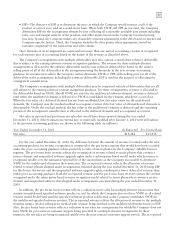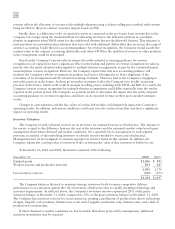Motorola 2010 Annual Report Download - page 57
Download and view the complete annual report
Please find page 57 of the 2010 Motorola annual report below. You can navigate through the pages in the report by either clicking on the pages listed below, or by using the keyword search tool below to find specific information within the annual report.
49
anticipate the cancellation of any of these agreements in the future and estimates that purchases from these suppliers
will exceed the minimum obligations during the agreement periods.
Other Obligations: In January 2011, the Pension Benefit Guaranty Corporation (“PBGC”) announced an
agreement with Motorola Solutions under which the Company will contribute $100 million above and beyond its
legal requirement to its U.S. Regular Pension Plan over the next five years. The Company and the PBGC entered
into the agreement as the Company was in the process of separating Motorola Mobility and pursuing the sale of
certain assets of it Networks business.
Commitments Under Other Long-Term Agreements: The Company has entered into certain long-term
agreements to purchase software, components, supplies and materials from suppliers. Most of the agreements
extend for periods of one to three years (three to five years for software). Generally, these agreements do not
obligate the Company to make any purchases, and many permit the Company to terminate the agreement with
advance notice (usually ranging from 60 to 180 days). If the Company were to terminate these agreements, it
generally would be liable for certain termination charges, typically based on work performed and supplier on-hand
inventory and raw materials attributable to canceled orders. The Company’s liability would only arise in the event it
terminates the agreements for reasons other than “cause.”
The Company outsources certain corporate functions, such as benefit administration and information
technology-related services. These contracts are expected to expire in 2013. Following the Separation of Motorola
Mobility, the Motorola Solutions’ total remaining payments under these contracts are approximately $517 million
over the remaining life of the contracts; however these contracts can be terminated. Termination would result in a
penalty substantially less than the remaining annual contract payments. The Company would also be required to
find another source for these services, including the possibility of performing them in-house.
As is customary in bidding for and completing certain projects and pursuant to a practice the Company has
followed for many years, the Company has a number of performance/bid bonds, standby letters of credit and surety
bonds outstanding (collectively, referred to as “Performance Bonds”), primarily relating to projects of the Enterprise
Mobility Solutions and Home segments, including projects related to discontinued operations. These Performance
Bonds normally have maturities of multiple years and are standard in the industry as a way to give customers a
convenient mechanism to seek resolution if a contractor does not satisfy certain requirements under a contract.
Typically, a customer can draw on the Performance Bond only if the Company does not fulfill all terms of a project
contract. If such an occasion occurred, the Company would be obligated to reimburse the institution that issued the
Performance Bond for the amounts paid. In its long history, it has been rare for the Company to have a Performance
Bond drawn upon. At December 31, 2010, outstanding Performance Bonds totaled approximately $1.7 billion,
compared to $1.9 billion at December 31, 2009. Following the Separation of Motorola Mobility, Motorola
Solutions’ outstanding Performance Bonds totaled approximately $1.6 billion. Any future disruptions, uncertainty,
or volatility in the bank, insurance or capital markets, or a change in the Company’s credit ratings could adversely
affect the Company’s ability to obtain Performance Bonds and may result in higher funding costs.
Off-Balance Sheet Arrangements: Under the definition contained in Item 303(a)(4)(ii) of Regulation S-K, the
Company does not have any off-balance sheet arrangements.
Long-term Customer Financing Commitments
Outstanding Commitments: Certain purchasers of the Company’s infrastructure equipment may request that
the Company provide long-term financing (defined as financing with a term of greater than one year) in connection
with the sale of equipment. These requests may include all or a portion of the purchase price of the equipment. The
Company’s obligation to provide long-term financing may be conditioned on the issuance of a letter of credit in
favor of the Company by a reputable bank to support the purchaser’s credit or a pre-existing commitment from a
reputable bank to purchase the long-term receivables from the Company. The Company had outstanding
commitments to provide long-term financing to third parties totaling $356 million at December 31, 2010, compared
to $406 million at December 31, 2009. Of these amounts, $27 million was supported by letters of credit or by bank
commitments to purchase long-term receivables at December 31, 2010, compared to $13 million supported at
December 31, 2009. The majority of the outstanding commitments at December 31, 2010 are to a small number of
network operators in the Middle East region. The Company will retain the funded portion of the financing
arrangements related to the Networks segment following the sale to NSN, which totaled approximately $235
million at December 31, 2010.


